Optimization of the Curved Metal Damper to Improve Structural Energy Dissipation Capacity
Abstract
:1. Introduction
2. B-Spline Basis Functions
3. Shape Optimization Based on Whale Optimization Algorithm
4. Finite Element Modeling Methodology
Verification Study
5. Optimization Process
6. Discussion and Results
7. Conclusions
Author Contributions
Funding
Data Availability Statement
Conflicts of Interest
References
- Vargas, R.E. Analytical and Experimental Investigation of the Structural Fuse Concept. Ph.D. Thesis, State University of New York, Buffalo, NY, USA, 2006. [Google Scholar]
- Mirzai, N.M.; Attarnejad, R.; Hu, J.W. Enhancing the seismic performance of EBFs with vertical shear link using a new self-centering damper. Int. J. 2018, 35, 57–76. [Google Scholar]
- Farzampour, A.; Khatibinia, M.; Mansouri, I. Shape optimization of butterfly-shaped shear links using Grey Wolf algorithm. Ing. Sismica 2019, 36, 27–41. [Google Scholar]
- Cetin, H.; Aydin, E. A New Tuned Mass Damper Design Method based on Transfer Functions. KSCE J. Civ. Eng. 2019, 23, 4463–4480. [Google Scholar] [CrossRef]
- Salari, S.; Hormozabad, S.J.; Ghorbani-Tanha, A.K.; Rahimian, M. Innovative Mobile TMD System for Semi-active Vibration Control of Inclined Sagged Cables. KSCE J. Civ. Eng. 2019, 23, 641–653. [Google Scholar] [CrossRef]
- Hu, X.; Lu, C.; Zhu, X.; Xie, X. A Theoretical Study of Estimating the Elastic Responses of Framed Self-Centering Wall Structures under Lateral Loading. KSCE J. Civ. Eng. 2020, 24, 3714–3725. [Google Scholar] [CrossRef]
- Sui, W.; Li, H.; Zhang, Q.; Wang, Z.; Jin, X. The Mechanical Properties of a New Corrugated Steel Plate Damper and Its Application in a Steel Arch Bridge. KSCE J. Civ. Eng. 2020, 24, 228–240. [Google Scholar] [CrossRef]
- Mirzai, N.M.; Cho, H.M.; Hu, J.W. Experimental study of new axial recentering dampers equipped with shape memory alloy plates. Struct. Control Health Monit. 2020, 28. [Google Scholar] [CrossRef]
- Mirzai, N.M.; Hu, J.W. Pilot study for investigating the inelastic response of a new axial smart damper combined with friction devices. Steel Compos. Struct. 2019, 32, 373–388. [Google Scholar] [CrossRef]
- Whittaker, A.; Bertero, V.; Alonso, J.; Thompson, C. Earthquake Simulator Testing of Steel Plate Added Damping and Stiffness Elements; Earthquake Engineering Research Center, University of California: Berkeley, CA, USA, 1989. [Google Scholar]
- Somarathna, H.; Raman, S.; Mohotti, D.; Mutalib, A.; Badri, K. The use of polyurethane for structural and infrastructural engineering applications: A state-of-the-art review. Constr. Build. Mater. 2018, 190, 995–1014. [Google Scholar] [CrossRef]
- Alehashem, S.M.S.; Keyhani, A.; Pourmohammad, H. Behavior and performance of structures equipped with ADAS & TADAS dampers. In Proceedings of the 14th World Conference on Earthquake Engineering, Beijing, China, 12–17 October 2008. [Google Scholar]
- Eldin, M.N.; Kim, J.; Kim, J. Optimum distribution of steel slit-friction hybrid dampers based on life cycle cost. Steel Compos. Struct. 2018, 27, 633–646. [Google Scholar] [CrossRef]
- Kim, J.; Kim, M.; Eldin, M.N. Optimal distribution of steel plate slit dampers for seismic retrofit of structures. Steel Compos. Struct. 2017, 25, 473–484. [Google Scholar] [CrossRef]
- Lor, H.A.; Izadinia, M.; Memarzadeh, P. Experimental evaluation of steel connections with horizontal slit dampers. Steel Compos. Struct. 2019, 32, 79–90. [Google Scholar] [CrossRef]
- Shahri, S.F.; Mousavi, S.R. Seismic behavior of beam-to-column connections with elliptic slit dampers. Steel Compos. Struct. 2018, 26, 289–301. [Google Scholar] [CrossRef]
- Ghamari, A.; Haeri, H.; Khaloo, A.; Zhu, Z. Improving the hysteretic behavior of Concentrically Braced Frame (CBF) by a proposed shear damper. Steel Compos. Struct. 2019, 30, 383–392. [Google Scholar] [CrossRef]
- Farzampour, A.; Mansouri, I.; Lee, C.-H.; Sim, H.-B.; Hu, J.W. Analysis and design recommendations for corrugated steel plate shear walls with a reduced beam section. Thin-Walled Struct. 2018, 132, 658–666. [Google Scholar] [CrossRef]
- Paslar, N.; Farzampour, A.; Hatami, F. Infill plate interconnection effects on the structural behavior of steel plate shear walls. Thin-Walled Struct. 2020, 149, 106621. [Google Scholar] [CrossRef]
- Farzampour, A.; Mansouri, I.; Hu, J.W. Seismic Behavior Investigation of the Corrugated Steel Shear Walls Considering Variations of Corrugation Geometrical Characteristics. Int. J. Steel Struct. 2018, 18, 1297–1305. [Google Scholar] [CrossRef]
- Farzampour, A.; Laman, J.A.; Mofid, M. Behavior prediction of corrugated steel plate shear walls with openings. J. Constr. Steel Res. 2015, 114, 258–268. [Google Scholar] [CrossRef]
- Lee, C.-H.; Ju, Y.K.; Min, J.-K.; Lho, S.-H.; Kim, S.-D. Non-uniform steel strip dampers subjected to cyclic loadings. Eng. Struct. 2015, 99, 192–204. [Google Scholar] [CrossRef]
- Lee, C.-H.; Lho, S.-H.; Kim, D.-H.; Oh, J.; Ju, Y.K. Hourglass-shaped strip damper subjected to monotonic and cyclic loadings. Eng. Struct. 2016, 119, 122–134. [Google Scholar] [CrossRef]
- Lee, C.-H.; Kim, J.; Kim, D.-H.; Ryu, J.; Ju, Y.K. Numerical and experimental analysis of combined behavior of shear-type friction damper and non-uniform strip damper for multi-level seismic protection. Eng. Struct. 2016, 114, 75–92. [Google Scholar] [CrossRef]
- Lee, C.-H.; Woo, S.-K.; Ju, Y.K.; Lee, D.-W.; Kim, S.-D. Modified Fatigue Model for Hourglass-Shaped Steel Strip Damper Subjected to Cyclic Loadings. J. Struct. Eng. 2015, 141, 04014206. [Google Scholar] [CrossRef]
- Hughes, T.J.R.; Cottrell, J.; Bazilevs, Y. Isogeometric analysis: CAD, finite elements, NURBS, exact geometry and mesh refinement. Comput. Methods Appl. Mech. Eng. 2005, 194, 4135–4195. [Google Scholar] [CrossRef] [Green Version]
- Shaaban, A.M.; Anitescu, C.; Atroshchenko, E.; Rabczuk, T. Shape optimization by conventional and extended isogeometric boundary element method with PSO for two-dimensional Helmholtz acoustic problems. Eng. Anal. Bound. Elem. 2020, 113, 156–169. [Google Scholar] [CrossRef]
- Auricchio, F.; DA Veiga, L.B.; Hughes, T.J.R.; Reali, A.; Sangalli, G. ISOGEOMETRIC COLLOCATION METHODS. Math. Models Methods Appl. Sci. 2010, 20, 2075–2107. [Google Scholar] [CrossRef] [Green Version]
- Bazilevs, Y.; Calo, V.; Cottrell, J.; Evans, J.; Hughes, T.; Lipton, S.; Scott, M.; Sederberg, T. Isogeometric analysis using T-splines. Comput. Methods Appl. Mech. Eng. 2010, 199, 229–263. [Google Scholar] [CrossRef] [Green Version]
- Chai, Y.; You, X.; Li, W.; Huang, Y.; Yue, Z.; Wang, M. Application of the edge-based gradient smoothing technique to acoustic radiation and acoustic scattering from rigid and elastic structures in two dimensions. Comput. Struct. 2018, 203, 43–58. [Google Scholar] [CrossRef]
- Deng, K.; Pan, P.; Sun, J.; Liu, J.; Xue, Y. Shape optimization design of steel shear panel dampers. J. Constr. Steel Res. 2014, 99, 187–193. [Google Scholar] [CrossRef]
- Pan, P.; Ohsaki, M.; Tagawa, H. Shape Optimization of H-Beam Flange for Maximum Plastic Energy Dissipation. J. Struct. Eng. 2007, 133, 1176–1179. [Google Scholar] [CrossRef] [Green Version]
- Farzampour, A.; Eatherton, M.R. Yielding and lateral torsional buckling limit states for butterfly-shaped shear links. Eng. Struct. 2019, 180, 442–451. [Google Scholar] [CrossRef]
- Farzampour, A.; Mansouri, I.; Dehghani, H. Incremental Dynamic Analysis for Estimating Seismic Performance of Multi-Story Buildings with Butterfly-Shaped Structural Dampers. Buildings 2019, 9, 78. [Google Scholar] [CrossRef] [Green Version]
- Farzampour, A. Structural behavior prediction of the Butterfly-shaped and straight shear fuses. Structures 2021, 33, 3964–3972. [Google Scholar] [CrossRef]
- Farzampour, A.; Eatherton, M.R. Parametric computational study on butterfly-shaped hysteretic dampers. Front. Struct. Civ. Eng. 2019, 13, 1214–1226. [Google Scholar] [CrossRef]
- Hajipour, F. Robust Radiotherapy Appointment Scheduling. Master’s Thesis, Concordia University, Montreal, QC, Canada, 2016. [Google Scholar]
- Mirjalili, S.; Lewis, A. The Whale Optimization Algorithm. Adv. Eng. Softw. 2016, 95, 51–67. [Google Scholar] [CrossRef]
- Rana, N.; Latiff, M.S.A.; Abdulhamid, S.M.; Chiroma, H. Whale optimization algorithm: A systematic review of contemporary applications, modifications and developments. Neural Comput. Appl. 2020, 32, 16245–16277. [Google Scholar] [CrossRef]
- Cao, Y.; Li, Y.; Zhang, G.; Jermsittiparsert, K.; Nasseri, M. An efficient terminal voltage control for PEMFC based on an improved version of whale optimization algorithm. Energy Rep. 2020, 6, 530–542. [Google Scholar] [CrossRef]
- Kiani, B.K.; Hashemi, B.H.; Torabian, S. Optimization of slit dampers to improve energy dissipation capacity and low-cycle-fatigue performance. Eng. Struct. 2020, 214, 110609. [Google Scholar] [CrossRef]
- Brando, G.; De Matteis, G. Design of low strength-high hardening metal multi-stiffened shear plates. Eng. Struct. 2014, 60, 2–10. [Google Scholar] [CrossRef]
- Lee, J.; Kim, J. Development of box-shaped steel slit dampers for seismic retrofit of building structures. Eng. Struct. 2017, 150, 934–946. [Google Scholar] [CrossRef]
- Ma, X.; Borchers, E.; Pena, A.; Krawinkler, H.; Billington, S.; Deierlein, G.G. Design and Behavior of Steel Shear Plates with Openings as Energy-Dissipating Fuses; Report No. 173; John A. Blume Earthquake Engineering Center: Stanford, CA, USA, 2010. [Google Scholar]
- He, H.; Wang, X.; Zhang, X. Energy-Dissipation Performance of Combined Low Yield Point Steel Plate Damper Based on Topology Optimization and Its Application in Structural Control. Adv. Mater. Sci. Eng. 2016, 2016, 5654619. [Google Scholar] [CrossRef] [Green Version]
- Farzampour, A. Evaluating Shear Links for Use in Seismic Structural Fuses. Ph.D. Thesis, Virginia Polytechnic Institute and State University, Blacksburg, VA, USA, 2018. [Google Scholar]
- Farzampour, A.; Eatherton, M.R. Parametric Study on Butterfly-shaped Shear Links with Various Geometries. In Proceedings of the 11th National Conference on Earthquake Engineering, 11NCEE, Los Angeles, CA, USA, 25–26 June 2018. [Google Scholar]
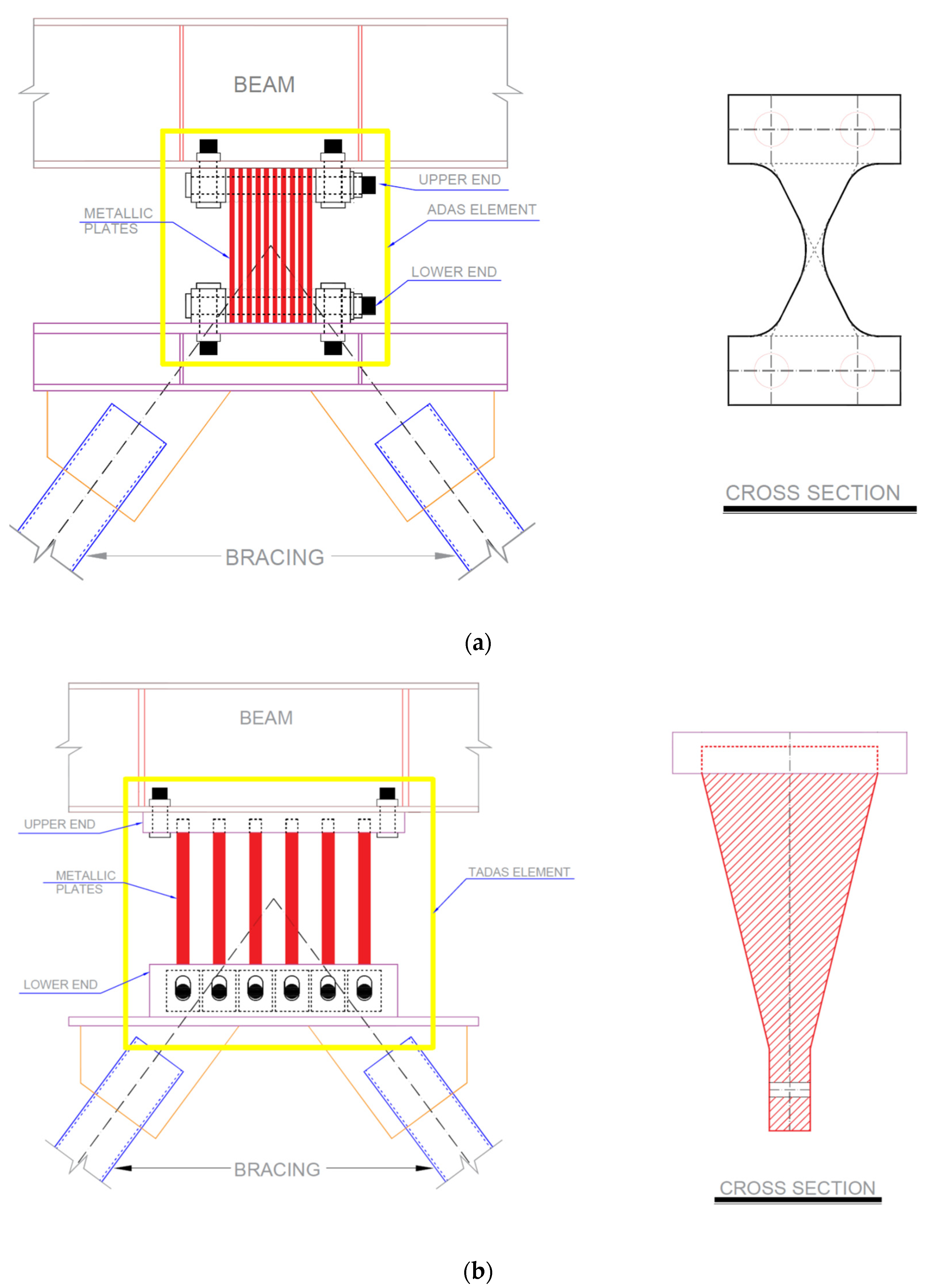
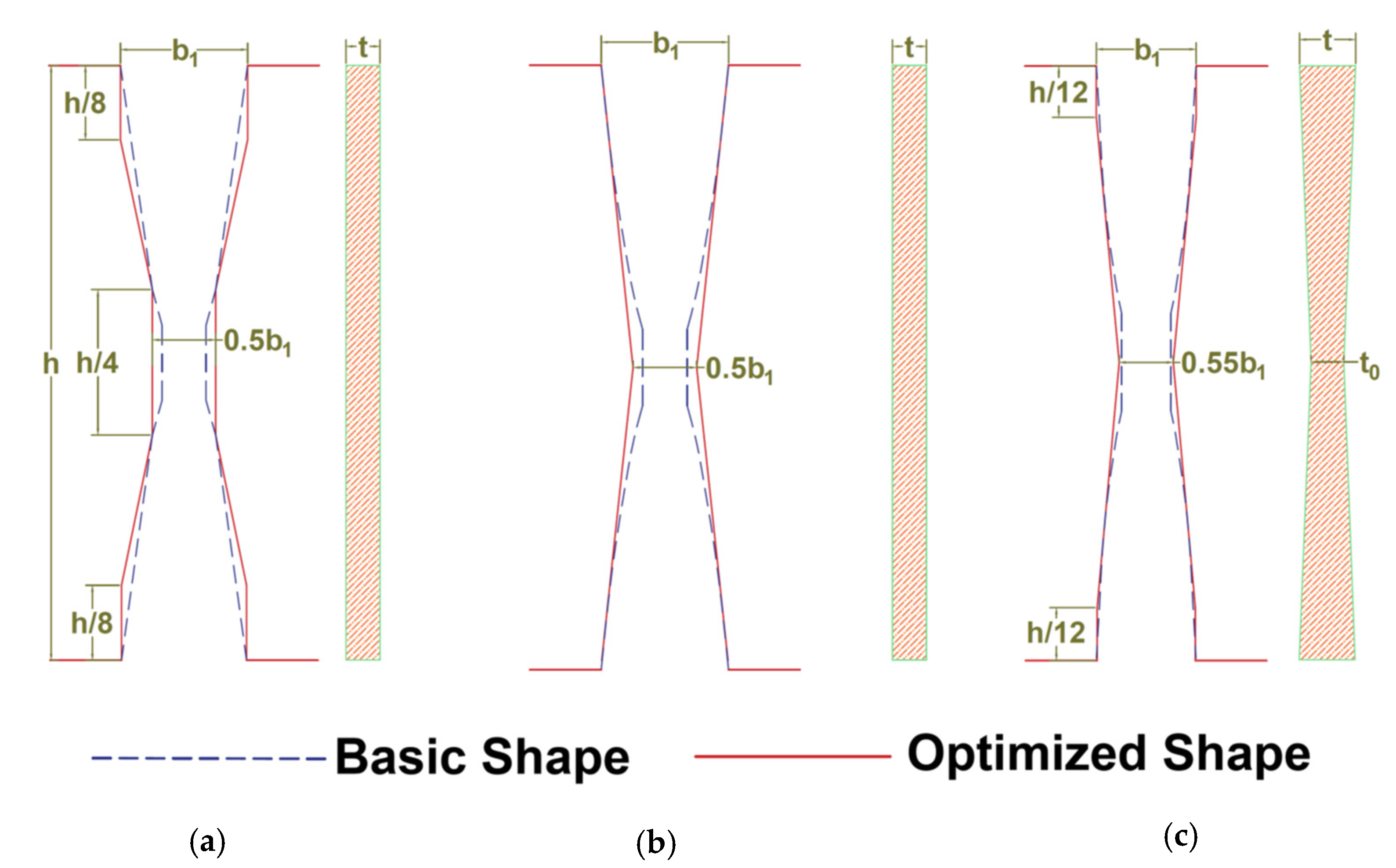
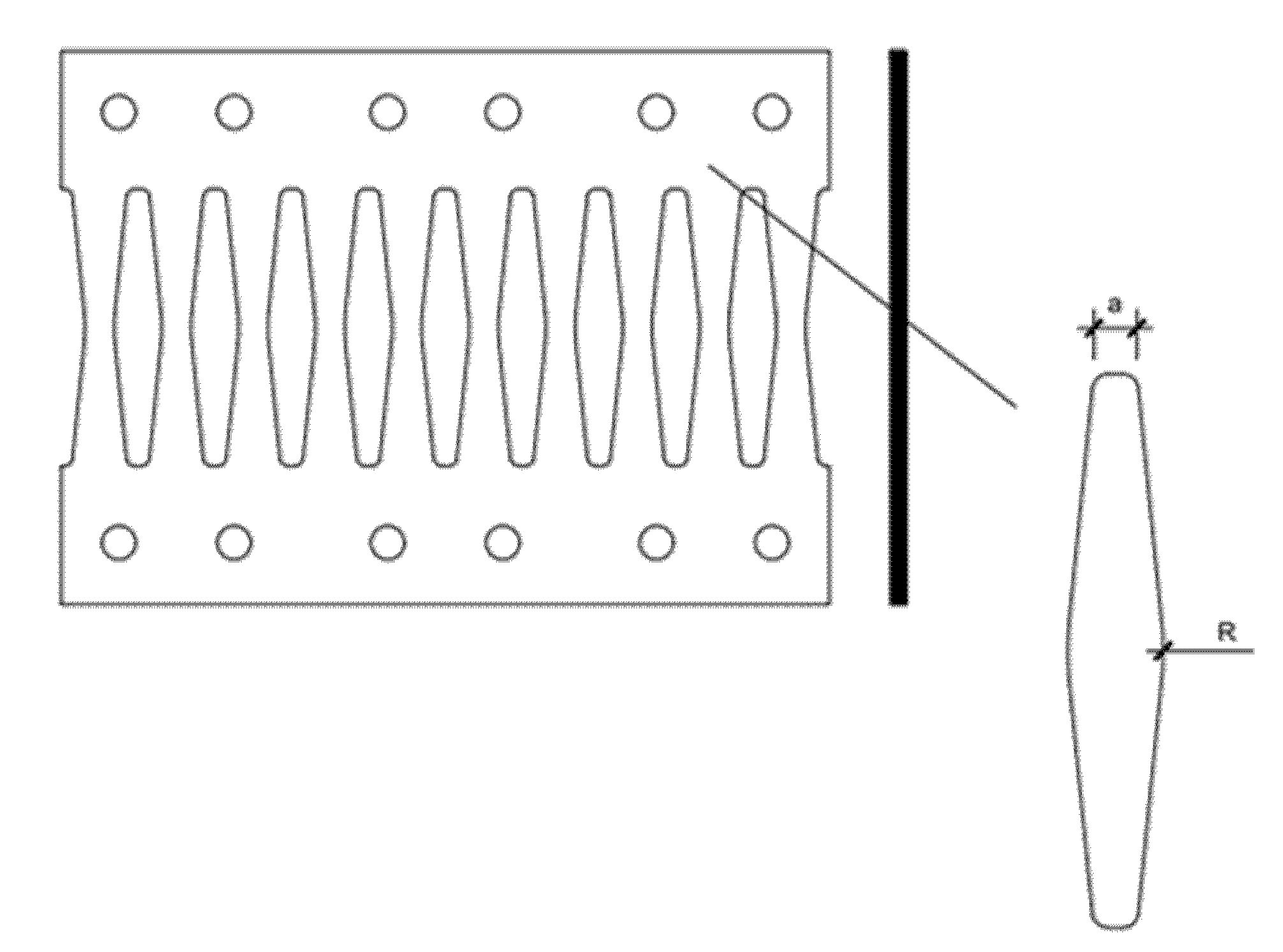

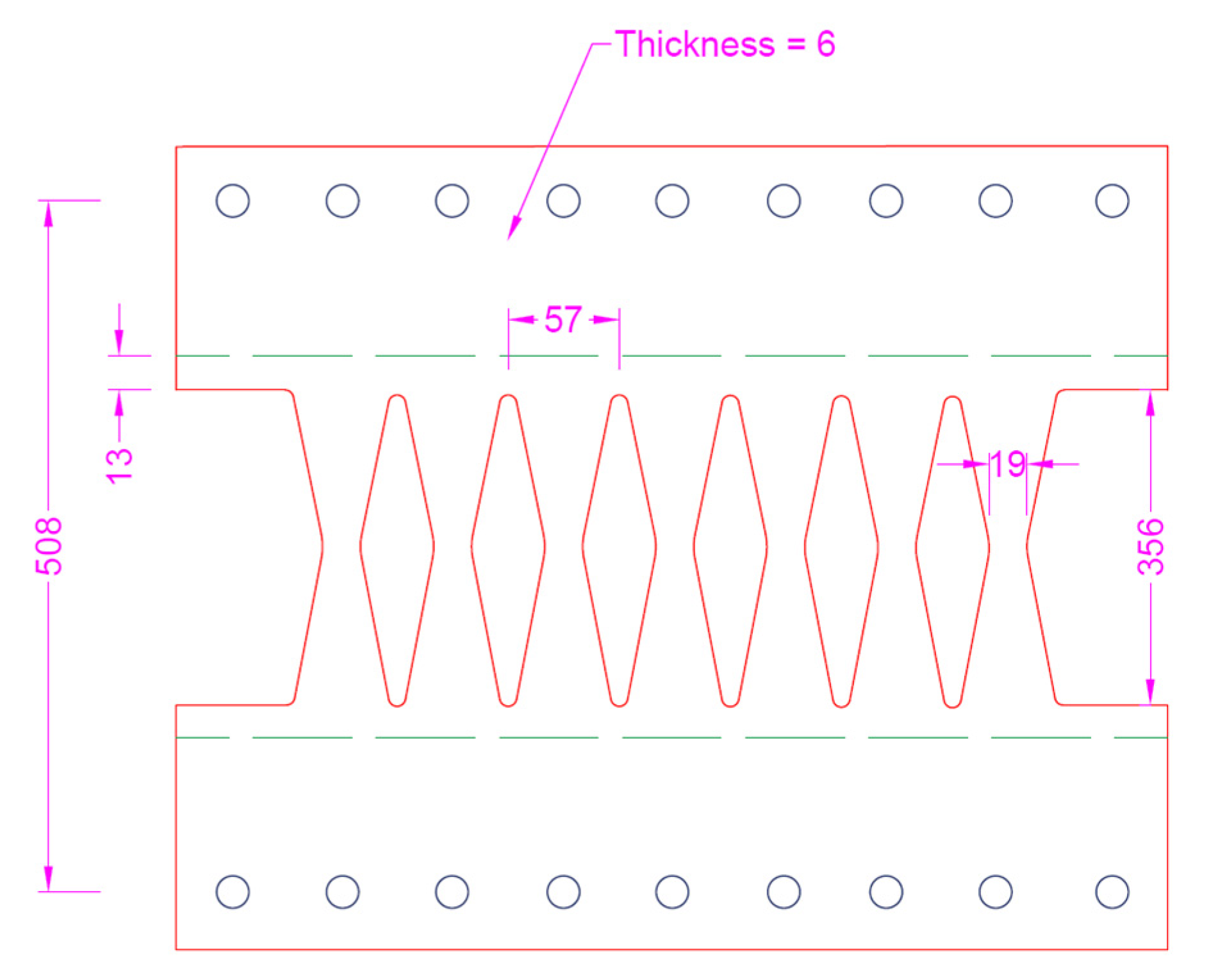

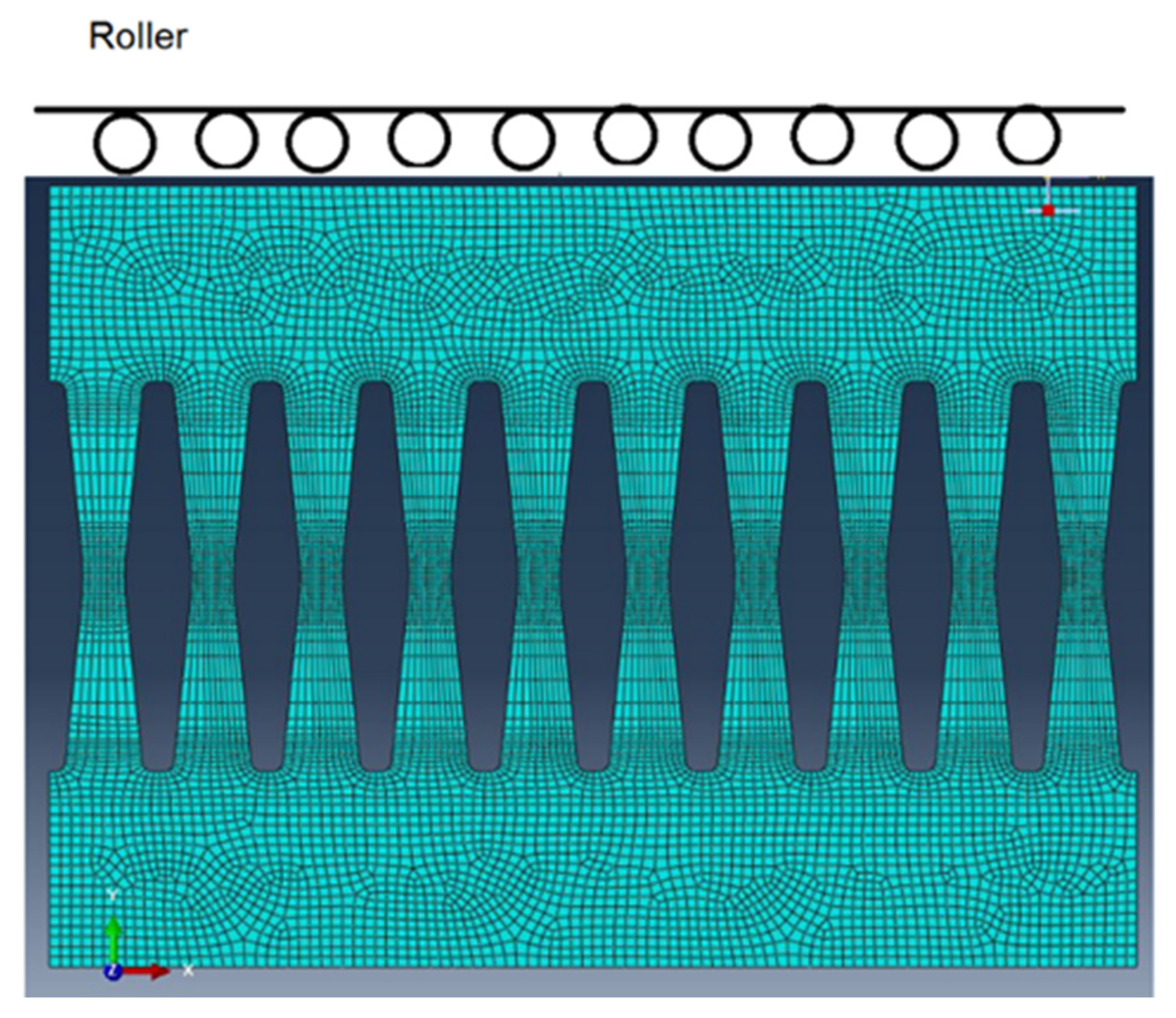
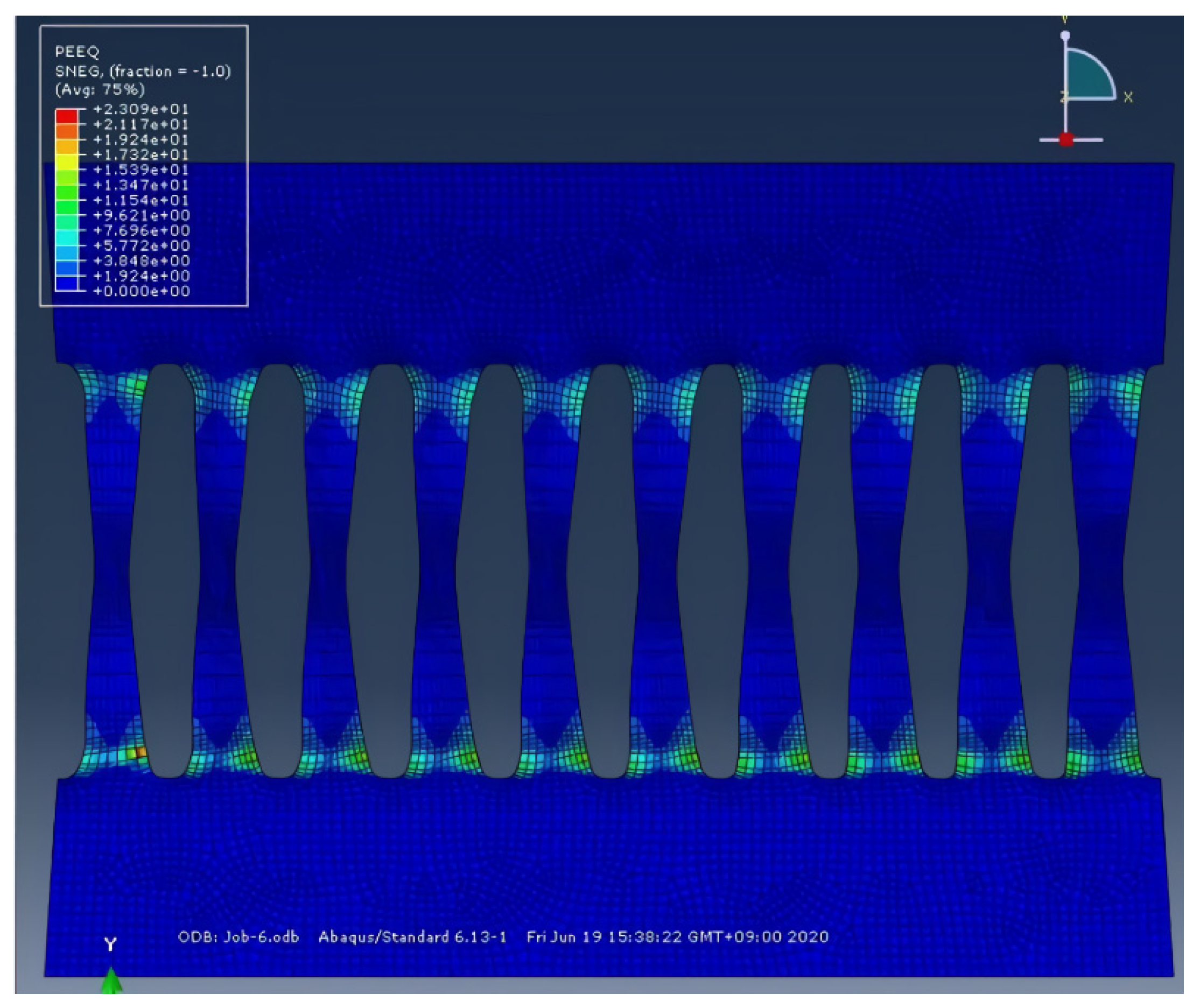

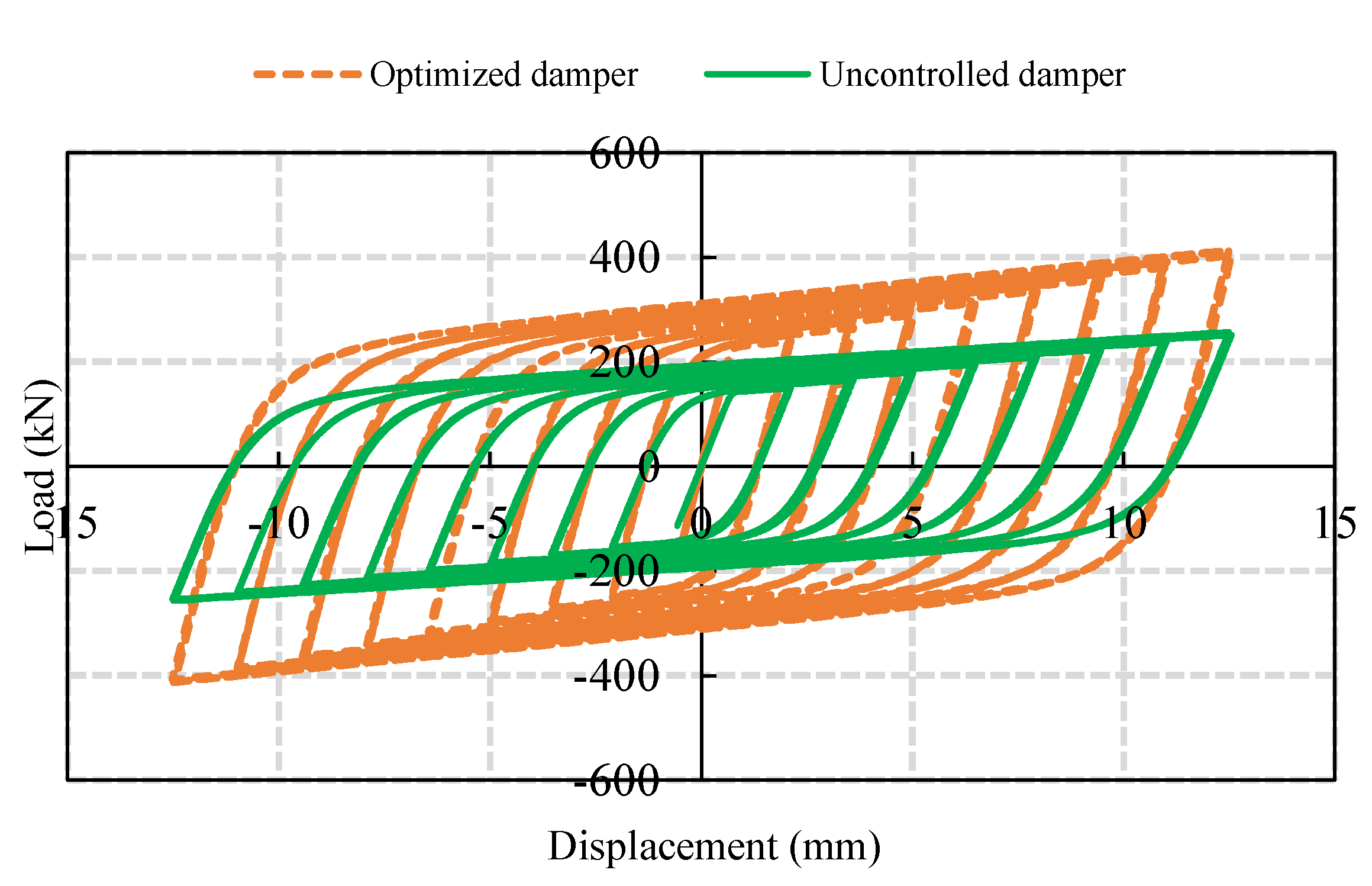
| No. | R (m) | t | a (m) | Normalized PEEQ max | Normalized Ed | Ed/[PEEQ Max] |
|---|---|---|---|---|---|---|
| 1 | 0.01 | 0.01 | 0.008 | 2.277 | 0.00204 | 454.48 |
| 2 | 0.01 | 0.01 | 0.154 | 1.552 | 0.02755 | 12,942.72 |
| 3 | 0.01 | 0.01 | 0.3 | 1.365 | 0.03298 | 16,138.86 |
| 4 | 0.01 | 0.01 | 0.154 | 1.8 | 0.08976 | 32,200.82 |
| 5 | 0.01 | 0.01 | 0.3 | 2.568 | 0.09604 | 27,755.22 |
| 6 | 0.005 | 0.01 | 0.008 | 0.99 | 0.03267 | 22,035.82 |
| 7 | 0.005 | 0.01 | 0.154 | 1.504 | 0.10584 | 41,170.14 |
| 8 | 0.005 | 0.01 | 0.3 | 1.199 | 0.1566 | 117,418.1 |
| 9 | 0.005 | 0.03 | 0.008 | 2.484 | 0.00505 | 1565.2 |
| 10 | 0.005 | 0.03 | 0.154 | 1.696 | 0.07826 | 34,796.81 |
| 11 | 0.0025 | 0.03 | 0.3 | 1.326 | 0.09464 | 55,264.65 |
| 12 | 0.0025 | 0.03 | 0.008 | 2.014 | 0.0513 | 18,161.97 |
| 13 | 0.0025 | 0.03 | 0.154 | 1.575 | 0.05586 | 24,732.18 |
| 14 | 0.0025 | 0.03 | 0.3 | 2.139 | 0.3069 | 84,241.59 |
| 15 | 0.0025 | 0.03 | 0.008 | 1.01 | 0.101 | 65,879.76 |
| 16 | 0.001 | 0.03 | 0.154 | 1.5 | 0.27027 | 128,421.1 |
| 17 | 0.001 | 0.03 | 0.3 | 0.9 | 0.618 | 367,647.2 |
| 18 | 0.001 | 0.05 | 0.008 | 2.162 | 0.009 | 2461.76 |
| 19 | 0.001 | 0.05 | 0.154 | 1.616 | 0.14688 | 61,602.24 |
| 20 | 0.001 | 0.05 | 0.3 | 1.274 | 0.17127 | 94,017.69 |
Publisher’s Note: MDPI stays neutral with regard to jurisdictional claims in published maps and institutional affiliations. |
© 2022 by the authors. Licensee MDPI, Basel, Switzerland. This article is an open access article distributed under the terms and conditions of the Creative Commons Attribution (CC BY) license (https://creativecommons.org/licenses/by/4.0/).
Share and Cite
Kim, Y.-C.; Mortazavi, S.J.; Farzampour, A.; Hu, J.-W.; Mansouri, I.; Awoyera, P.O. Optimization of the Curved Metal Damper to Improve Structural Energy Dissipation Capacity. Buildings 2022, 12, 67. https://doi.org/10.3390/buildings12010067
Kim Y-C, Mortazavi SJ, Farzampour A, Hu J-W, Mansouri I, Awoyera PO. Optimization of the Curved Metal Damper to Improve Structural Energy Dissipation Capacity. Buildings. 2022; 12(1):67. https://doi.org/10.3390/buildings12010067
Chicago/Turabian StyleKim, Young-Chan, Seyed Javad Mortazavi, Alireza Farzampour, Jong-Wan Hu, Iman Mansouri, and Paul Oluwaseun Awoyera. 2022. "Optimization of the Curved Metal Damper to Improve Structural Energy Dissipation Capacity" Buildings 12, no. 1: 67. https://doi.org/10.3390/buildings12010067
APA StyleKim, Y.-C., Mortazavi, S. J., Farzampour, A., Hu, J.-W., Mansouri, I., & Awoyera, P. O. (2022). Optimization of the Curved Metal Damper to Improve Structural Energy Dissipation Capacity. Buildings, 12(1), 67. https://doi.org/10.3390/buildings12010067








